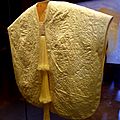Spider silk facts for kids
Most spiders can produce a natural fibre which they use for different purposes. This fibre is called spider silk. Depending on the type of spider, spider silk is uses for purposes of catching prey (either by weaving a net, or by throwing a sticky thread at prey), to get away from predators, and to protect the eggs and the young in a cocoon. Spider silk is very resistant, and has a high tensile strength, it does not tear easily.
Unlike the silk from silkworms, spider silk cannot be produced in large quantities.
Images for kids
-
Indian Summer by Józef Chełmoński (1875, National Museum in Warsaw) depicts a peasant woman with a thread of gossamer in her hand.
-
Schematic of the spiders spinning apparatus and structural hierarchy in silk assembling related to assembly into fibers. In the process of dragline production, the primary structure protein is secreted first from secretory granules in the tail. In the ampullate (neutral environment, pH = 7), the proteins form a soft micelle of several tens of nanometers by self-organization because the hydrophilic terminals are excluded. In ampullate, the concentration of the protein is very high. Then, the micelles are squeezed into the duct. The long axis direction of the molecules is aligned parallel to the duct by a mechanical frictional force and partially oriented. The continuous lowering of pH from 7.5 to 8.0 in the tail to presumably close to 5.0 occurs at the end of the duct. Ion exchange, acidification, and water removal all happen in the duct. The shear and elongational forces lead to phase separation. In the acidic bath of the duct, the molecules attain a high concentration liquid crystal state. Finally, the silk is spun from the taper exterior. The molecules become more stable helixes and β-sheets from the liquid crystal.
-
Schematic of the spider's orb web, structural modules, and spider silk structure. On the left is shown a schematic drawing of an orb web. The red lines represent the dragline, radial line, and frame lines, the blue lines represent the spiral line, and the centre of the orb web is called the "hub". Sticky balls drawn in blue are made at equal intervals on the spiral line with viscous material secreted from the aggregate gland. Attachment cement secreted from the piriform gland is used to connect and fix different lines. Microscopically, the spider silk secondary structure is formed of spidroin and is said to have the structure shown on the right side. In the dragline and radial line, a crystalline β-sheet and an amorphous helical structure are interwoven. The large amount of β-spiral structure gives elastic properties to the capture part of the orb web. In the structural modules diagram, a microscopic structure of dragline and radial lines is shown, composed mainly of two proteins of MaSp1 and MaSp2, as shown in the upper central part. In the spiral line, there is no crystalline β-sheet region.
See also
 In Spanish: Seda de araña para niños
In Spanish: Seda de araña para niños












